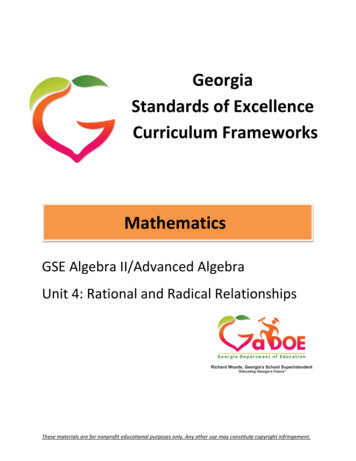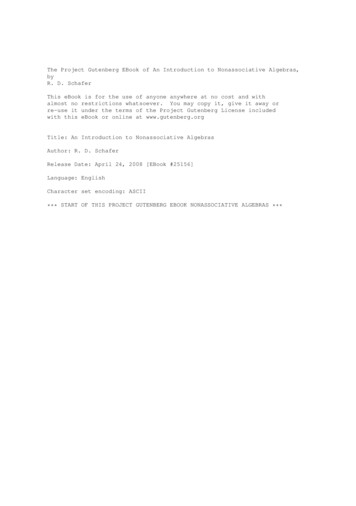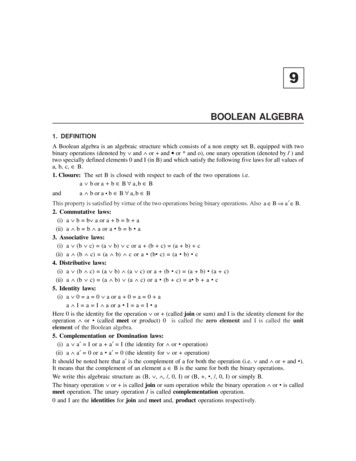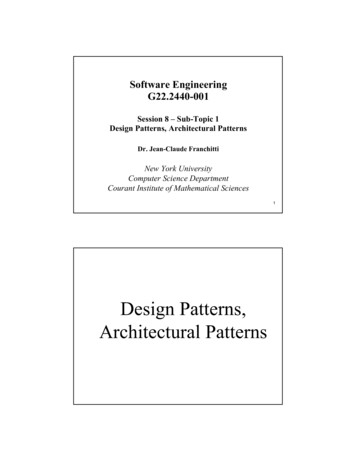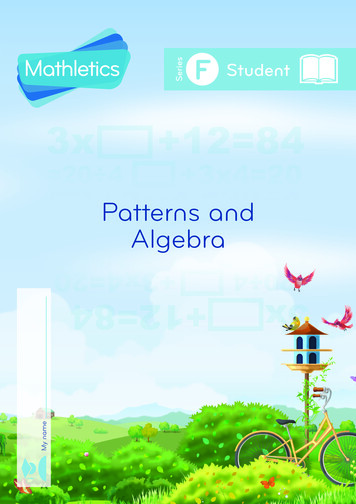
Transcription
Series3xFStudent 12 84 3x4 20 20 4 3x4Patterns andAlgebra 20 4 3x4 20 43x 3x4 20 12 84My name 20 4
Copyright 2009 3P Learning. All rights reserved.First edition printed 2009 in Australia.A catalogue record for this book is available from 3P Learning Ltd.ISBN978-1-921860-80-5Ownership of content The materials in this resource, including without limitation all information, text,graphics, advertisements, names, logos and trade marks (Content) are protected by copyright, trade markand other intellectual property laws unless expressly indicated otherwise.You must not modify, copy, reproduce, republish or distribute this Content in any way except as expresslyprovided for in these General Conditions or with our express prior written consent.Copyright Copyright in this resource is owned or licensed by us. Other than for the purposes of, andsubject to the conditions prescribed under, the Copyright Act 1968 (Cth) and similar legislation whichapplies in your location, and except as expressly authorised by these General Conditions, you may notin any form or by any means: adapt, reproduce, store, distribute, print, display, perform, publish or createderivative works from any part of this resource; or commercialise any information, products or servicesobtained from any part of this resource.Where copyright legislation in a location includes a remunerated scheme to permit educationalinstitutions to copy or print any part of the resource, we will claim for remuneration under that schemewhere worksheets are printed or photocopied by teachers for use by students, and where teachersdirect students to print or photocopy worksheets for use by students at school. A worksheet is a page oflearning, designed for a student to write on using an ink pen or pencil. This may lead to an increase inthe fees for educational institutions to participate in the relevant scheme.Published 3P Learning LtdFor more copies of this book, contact us at: www.3plearning.com/contactDesigned3P Learning LtdAlthough every precaution has been taken in the preparation of this book, the publisher and authorsassume no responsibility for errors or omissions. Neither is any liability assumed for damages resultingfrom the use of this information contained herein.
Series F – Patterns and AlgebraContentsTopic 1 – Patterns and functions (pp. 1–12)Date completed recursive number patterns// function number patterns// matchstick patterns// function machines// function tables with addition and subtraction// function tables with multiplication// rows and columns – apply// pizza pizzazz – solve// understanding equivalence// using symbols// keeping balance// magician’s hat trick – solve// Dhiffushi island currency – solve// balance strategy using inverse operations// word problems// think of a number// number tricks 1 – solve// number tricks 2 – solve//Topic 2 – Equations and equivalence (pp. 13–20)Topic 3 – Using equations (pp. 21–28)Series Authors:Rachel FlenleyNicola HerringerCopyright
Patterns and functions – recursive number patternsLook around you, can you see a pattern? A pattern is an arrangement of shapes, numbers orobjects formed according to a rule. Patterns are everywhere, you can find them in nature, art,music and even in dance!In this topic, we are looking at number patterns. A number pattern is a sequence or list of numbersthat is formed according to a rule.Number patterns can use any of the four operations ( , –, , ) or even a combination.In the example below, if we follow this instruction: “starting at 1 add 5 each time” we get thisnumber pattern:16111621 512 5 5Write the next 3 numbers in each sequence by following the rule:a Rule: add 65 11 17 b Rule: subtract 10100 90 80 c Rule: multiply by 22 4 8 Figure out the missing numbers in each pattern and write the rule. Circle the ascending patterns.a14 2135 42bRuled16 244017 37 57cRuleeRule3 563 5436 277530 15RulefRule63 5642 35RuleComplete these grid patterns. Look closely at the numbers in the grid and follow the patterns.ab663240425052c3768417232596Patterns and AlgebraCopyright 3P LearningF1SERIESTOPIC1
Patterns and functions – recursive number patternsSome number patterns can be formed with 2 operations each time. For example: 2 32 2 37 2 31737The rule is multiply by 2 and add 3 each time.4With these number patterns, write the rule as 2 operations in the diamond shapes and describe it underneath.a 2 1410222267The rule is 3 2b7The rule is5Lena and Max were asked to show a number pattern for different rules. Check each sequence and puta circle around any errors. You may use a calculator.a Start at 2, add 1 and multiply by 2Lena2614306212625451010221838781583206401280b Start at 3, add 1 and multiply by 2Max638Look at each pattern of shapes and see if you can predict the following:a123456789108910What will shape number 20 look like? Draw it here:What will shape number 33 look like? Draw it here:b1234567What will shape number 15 look like? Draw it here:What will shape number 26 look like? Draw it here:2F1SERIESTOPICPatterns and AlgebraCopyright 3P Learning
Patterns and functions – function number patternsThere are 2 different types of rules that a number pattern can be based upon:1 A recursive rule – used to continue the sequence by doing something to the number before it.2 A function rule – used to predict any number by applying the rule to the position of the number.A function rule is a rule based on the position of a number.Consider this. Lucia was given this number pattern:510152025Her teacher asked her to work out what the 20th number would be without continuing the sequence.Lucia used a table to work out the rule between the position of a number and the number in thepattern. She worked out the rule to be 5.Position of numberFunction ruleNumber pattern1234520 5 5 5 5 5 5510152025100So, following the rule based on the position of a number, the 20th number is 100.This is a function rule.1Use the function rule and then apply the rule to position 20.aPosition of number12345Number pattern612182430Position of number1234520Function ruleb20Function rulecNumber pattern48121620Position of number12345Number pattern816243240Position of number1234511151923HINT: In thelast pattern,the rule has2 operations.20Function ruledFunction ruleNumber pattern20 4 7Patterns and AlgebraCopyright 3P LearningF1SERIESTOPIC3
Patterns and functions – function number patternsFunction rules with 2 operations are easy to work out when we look at how they are linked tothe multiplication tables.Position of number123452 times table 32 34 36 38 310 3Number pattern5791113Function ruleMultiply by 2 and then add 3This table shows that the number pattern is the same as the 2 times table with 3 added toeach answer.2Complete each table to show how function rules with 2 operations can be linked to multiplication tables.aPosition of number3 times table Number pattern123453 6 9 12 15 710131619Function rulebPosition of number6 times table Number patternMultiply by 3 and then add123456 12 18 24 30 814202632Function rulecPosition of numberMultiply by 6 and then add123451119273543345times table Number patternFunction rule3Complete this table to show the 4 times tables with 2 added.aPosition of number124 times table 2Number patternFunction ruleb What would the number in the 20th position be?4F1SERIESTOPICPatterns and AlgebraCopyright 3P Learning
Patterns and functions – matchstick patternsUse the function rule to predict geometric patterns with matchsticks. Here is an example.Mia made this sequence of shapes with matchsticks:Shape 1Shape 2Shape 3Shape 4If Mia followed this sequence, how many matchsticks will she need for shape 20?Shape numberNumber of matchsticksFunction rule113263941251520603Number of matchsticks Shape number Complete the table for each sequence of matchstick shapes. Use the function rule for finding the numberof matchsticks needed for the shape in the 20th position.aShape 1123Number of matchsticks4812Shape 2205Shape 3Shape number123Number of matchsticks612184205Number of matchsticks Shape number Shape 1Shape 2Shape 3Shape number123Number of matchsticks71421Function rule4Number of matchsticks Shape number Shape 1Function rulecShape 3Shape numberFunction rulebShape 24205Number of matchsticks Shape number Patterns and AlgebraCopyright 3P LearningF1SERIESTOPIC5
Patterns and functions – matchstick patternsThis time the rule for this matchstick pattern has 2 operations. Can you see why?Look for a multiplication pattern and how many extra there are in each shape.Look for a repeating element.Shape 12Shape 2Then look to see what is added.These are circled in the sequence below.Shape 3Shape 1 has 3 matchsticks 1 2 1 3Shape 2 has 5 matchsticks 2 2 1 5Shape 3 has 7 matchsticks 3 2 1 7Shape numberNumber of matchsticks132537495112041Function ruleNumber of matchsticks Shape number 2 1In each of these patterns, look for the repeating element and then what is added each time:aShape 1Shape 2Shape 3Shape number123Number of matchsticks4710Function ruleb520Number of matchsticks Shape number Shape 1Shape number4Shape 21Shape 3234520Number of matchsticksFunction rulecNumber of matchsticks Shape number Shape 1Shape numberShape 21Shape 3234520Number of matchsticksFunction rule6F1SERIESTOPICNumber of matchsticks Shape number Patterns and AlgebraCopyright 3P Learning
Patterns and functions – function machinesThis is a function machine.Numbers go in, have the rule applied,and come out again.INOUTRULE:26 382410130Look carefully at the numbers going in these function machines and the numbers coming out.What rule are they following each time?abINOUTIN73813945152073522RULE:15What numbers will come out of these function machines?abIN211RULE:OUTIN 6244893OUTRULE:OUTRULE: 872What numbers go in to these number function machines?abINRULE:– 12OUTINOUTRULE: 22241550343270Patterns and AlgebraCopyright 3P LearningF1SERIESTOPIC7
Patterns and functions – function machines4Write the rule in each double function machine. Each rule is made up of 2 operations ( then 1224411168332RULE:35OUTRULE:OUTRULE:50Which function machine will win this game of bingo? Write the numbers that come out and colour eachmachine’s numbers in a different colour. Check which machine has 3 numbers in a line in any direction.INOUT1232716451217 2 4316354F1SERIESTOPICOUTPatterns and AlgebraCopyright 3P Learning35 5 22
Patterns and functions – function tables with addition and subtractionThe function machines showed us that when a number goes in, it comes out changed by the ruleor the function. There are many function patterns in real life.Look at this example:At their Christmas fair, Middle Street Primary School charges 1.50 for a gift wrapping service.This table shows the total cost of each wrapped gift and shows the rule.Cost of unwrapped giftCost of wrapped giftRule1 7 10 15 18 8.50 11.50 16.50 19.50Cost of unwrapped gift 1.50 Cost of wrapped giftComplete the function table for the total cost of a day out at a fun park. You must pay an entry fee of 12and purchase a wrist band for the amount of rides that you want to go on.Wrist band5 rides for 206 rides for 257 rides for 308 rides for 35Total admissionRule2Wrist band 12 Total costComplete the function table for the total cost of lunch at a school canteen. Students pay 2.40 for asandwich and then choose what else they would like. Work out the total cost of lunch for each option.Lunch optionDrink: 80 Fruit: 95 Yoghurt: 1.10Ice block: 1.50Total cost of lunchRule3Lunch option 2.40 Total cost of lunch5F have fitness every Thursday afternoon for 30 minutes. Each week they complete a fitness activity andthen play running games. Work out how much time is left for games after each activity.ActivitySkipping10 minutesStar jumps12 minutesPush ups15 minutesSit ups16 minutesTime left for gamesRule30 minutes – length of time of activity Time left for gamesPatterns and AlgebraCopyright 3P LearningF1SERIESTOPIC9
Patterns and functions – function tables with multiplicationLet’s look at more real life function tables, this time based on multiplication.By working out the function, you can extend the pattern to find out unknowns.For example:A bakery makes 10 cupcakes an hour.The rule to work out the number of cupcakes this bakery produces within a certain amount of time is:Number of hours 10 Number of cupcakesHours12345678Cupcakes1020304050607080How many cupcakes will it make in 1 day?This table only goes up to 8 hours but we can use the function to answer this question:24 hours 10 cupcakes 240 cupcakes1Complete the function tables, write the rule and answer the question.A dry cleaner charges 2 to iron a shirt.aNumber of shirts123Cost 2 4 645678Write the rule for finding out the cost of ironingshirts when you know how many shirts:How much does it cost to have 12 shirts ironed?Monica and Anna have a lemonade stand outside their house. For every litre of lemonade they make4 cups to sell.bLitres12Cups483456785678Write the rule for finding out howmany cups are needed when you knowhow many litres have been made:How many cups will be needed if they haveenough to make 12 litres of lemonade?cAt a cinema, the lollies are sold by weight. 1 scoop costs 50 .Scoops of lolliesCost1250 134Write the rule to find out the cost of thelollies when you know how many scoops:How many scoops of lollies can I get for 10?10F1SERIESTOPICPatterns and AlgebraCopyright 3P Learning
Rows and columnsGettingreadyWhatto doapplyThis is a game for 2 players. For this game you will need 2 dice, this pageand 12 counters each, in 2 different colours. A calculator is optional.Roll both dice, add them together and put this value in the function rule.For example, if I roll 3 and 5, I add these and get 8. I put 8 into the first rule and get8 7 – 3 53. I place one of my counters on 53.If the answer is already taken, you lose a turn.The winner is the player with the most counters in any row or column after 3 roundsof each function rule. (The numbers do not have to be next to each other, althoughyou could play like that if you wanted a longer game.)Function Rule 1Function Rule 2 7–3What todo nextFunction Rule 36 (8 ) – 8081828384858687888990919293949596979899 100Change the object of the game. For example, the winner might be the person whohas their counters on the most even numbers.Patterns and AlgebraCopyright 3P LearningF1SERIESTOPIC11
Pizza PizzazzGettingreadysolvePizza Pizzazz is the name of a pizza delivery companythat you work for on the weekends. You drive all aroundtown delivering hot and tasty pizzas in record time.To encourage you to uphold the company guaranteeof delivering pizzas in record time, your boss hasgiven you a choice of bonus scheme.Whatto doWhich scheme pays the best bonus?Use the tables below to work out which payment system is best.Payment System 1For each pizza that you deliver,you will get 2.Number of pizzasBonusPayment System 2For each pizza that you deliver, yourbonus will double, starting at 50 .Number of pizzas1122334455667788991010BonusWhich bonus scheme would you choose and why?What todo nextCan you think of when the other bonus scheme would be better?Which bonus scheme do you think your boss would prefer you to choose?12F1SERIESTOPICPatterns and AlgebraCopyright 3P Learning
Equations and equivalence – understanding equivalenceAn equation is like a set of balanced scales. Both sides are equal.Look at the scale on the right.On one side are 4 black triangles and 3 grey triangles.On the other side is the problem 4 3.Is this a balanced equation?Yes, because they both represent 7.4 34 3 7Sometimes, we haven’t been given all the information andwe have to work it out. This is what algebra is – solving missing number puzzles.1Make these scales balance by adding the missing value:ab5 25 These scales have number problems on each side. One side has a complete problem. On the other side,you need to work out the missing value. Write the value in the box so that the scales balance:ace5 19 11 155 99 b18 d50 – 14– 535 7100 – 19It will help towrite the answersnext to each sum.f33 322 –Patterns and AlgebraCopyright 3P LearningF2SERIESTOPIC13
Equations and equivalence – understanding equivalenceIf the sides are not balanced, we say the equation is unequal.Look at these scales:5 4 is greater than 5 4So instead of an equals sign, we use the greater than sign:5 4 5 43Complete the following scales and inequalities by adding greater than ( ) or less than ( ):ab12 133 812 48 712 138 743 812 4In these problems, you have to add both the symbol and a value that would make the equation true.Remember, just like with ordinary scales, the bigger value will be lower down.a17 ?b7 74 12 17 c7 7120 –?100 –d8 69 9 99 914120 –F2SERIESTOPIC?100 –4 128 6Patterns and AlgebraCopyright 3P Learning9 ?HINT: there aremany valuesthat would workin the boxes!
Equations and equivalence – using symbolsSymbols help us when we have more than one number to find.A symbol can be any shape and stands for any unknown numbers.1Work out the value of the diamond in each question. Notice the same symbol is added 3 times.Your 3 times tables will help here.a12b36c2345 12 36 45Find the value of the symbols. Remember that if a symbol is usedmore than once, it means it is the same value again.a 9 b 36 c 49 Guess, check and improvestrategy will help here.Find the value of the symbols and then check if you are right by usingthe same value in the question alongside it.ab 81 36 29 60 Patterns and AlgebraCopyright 3P LearningF2SERIESTOPIC15
Equations and equivalence – using symbolsKnown values can help us work out the values of the secret symbols.Your knowledge of inverse operations will also come in handy. 12 20 13 4 20, so 8By knowing the value of , we can work out 12 8 13, so 5 15 40 65 This time you must find the value of 3 different symbolsa 16 100 – 54 9 3 b 16 we can work out Look carefully at the example above and follow the steps to find out the values of these secret symbols:a5By knowing the value ofb using the clues in each step: 50 5 c 13 – F2SERIESTOPICPatterns and AlgebraCopyright 3P Learning 20 72 5
Equations and equivalence – keeping balanceWe can work out how many counters are in each box by keeping balance.Here is our equation. How do we work out how many countersare in each box? We use a symbol to represent the unknown.2 2 10If we take away 2 from each side, we maintain the balanceand make the problem easier. We now have to work outthe value of2 82 4 8This works because 2 4 2 101Find out how many counters are in each of the boxes. Remember to take away the same amount on bothsides so the balance is kept.afrom each side. This leaves me with:I will take away3 This works because 3 b 2 11from each side. This leaves me with:I will take away2 This works because 2 c I will take away from each side. This leaves me with: This works because 2 Patterns and AlgebraCopyright 3P Learning F2SERIESTOPIC17
Equations and equivalence – keeping balanceIn this activity you need to find out what each counter is worth.Step 1 Make the number stand alone by keeping balance.Step 2 Write an equation to solve.2424 6 42Look carefully at each balanced scale and work out what the symbols equal:ab1818 4949 c d6060 3636 3 This time use guess, check and improve to work out what the value of the symbols could be. The symbolshave the same value on both scales. 16 12 18F2SERIESTOPICPatterns and AlgebraCopyright 3P Learning
Magician’s hat trickGettingreadysolveMandana the magician is the master of optical illusions, magic tricks anddisappearing acts.One of his favourite tricks, is the disappearing act where he waves his wandand things disappear or do they?Abrakazaamabrakazoo look carefully atthese clues!Work out what he has hidden under his top hat.Clue: It is only one thing – either a rabbit, a book or a pineapple.CLUE 1CLUE 2Whatto doUnderneath Mandana the magician’s hat is:Patterns and AlgebraCopyright 3P LearningF2SERIESTOPIC19
Dhiffushi island currencyGettingreadyWhatto dosolveOn the holiday island of Dhiffushi, instead ofmoney, they use shells, beads and pebbles.Instead of a dollar sign they have this: D D,which stands for Dhiffushi Dollars.Work out what this currency is equal to by looking at these clues: KeyShell Bead Pebble DD8Using the symbol D D, convert the price of each of the following :1 pebble so 3 pebbles 1 bead so 2 beads 1 shell so 4 shells Using Dhiffushi currency, draw what I could use to pay for the following:Snorkeling D D 36Rainforest trip D D 40Turtle watching D D 54Diving D D 72In Dhiffushi currency, how much was my accommodation if I paid:My accommodation would be20F2SERIESTOPICPatterns and AlgebraCopyright 3P Learning
Using equations – balance strategy using inverse operationsHow can we find out the value of the symbol in this equation?We need to make it stand on its own while keeping theequation balanced. This is called the balance strategy.We do this by performing the inverse operation to both sides.Can you see why? 5 20Doing theinverse cancelsout a numberand helps getthe unknown tostand on its own. 5 5 20 5 41Practise performing inverse operations by getting back to the first number. The first one has been donefor you:a 202 5 4b 35 5 35 8 64d 72 8 72e 54 9 54f 18 6 18Find out the value of each symbol by performing inverse operations: 8 8 64 7b 7 64 56 56 Find out the value of each symbol again. Perform the inverse operation in fewer steps.a4 20c 64a3 5 9 5b 5 12 5 5 Find out the value of each symbol by following the same steps as above. Set your work out neatly:a 6 54b 5 125Patterns and AlgebraCopyright 3P LearningF3SERIESTOPIC21
Using equations – balance strategy using inverse operationsSometimes the symbol is not at the beginning so you have to rearrange the equation byperforming an inverse operation. This is because it is easier to solve when the symbol is on the lefthand side of the equals sign.12 78 – Step 1 M ove the symbol to the left with an inverse operation. The inverse of is – :12 78 – Step 2 M ake the symbol stand alone with an inverse operation. To do this, subtract 12 from both sides:12 78 – 12Step 3 Now we can perform a simple subtraction to find out the value of the symbol: 78 – 12 665Follow the steps outlined above to find the value of the symbol.a23 56 – c e26 78 –F3SERIESTOPICb32 78 – –36 112 – 22 d fPatterns and AlgebraCopyright 3P Learning –52 105 – – 14 92 – –
Using equations – word problemsIf you can solve equations with one unknown number using thebalance strategy, you will be able to solve word problems with ease!To get the star on its own weuse the inverse operation anddo the same to the other side.A large group of friends signed up to participate in a fun run.56 of them got food poisoning the day before so had to pull out.How many people signed up if a total of 84 people ran the race? – 56 84 – 56 84 56 1401Solve the following word problems using inverse operations. Start by choosing the matching equationfrom the box below. 50 130 – 70 m 38 m 83 100 300a Jack had a piece of rope and cut off 70 metres. He was left with 38 metres. How long was the rope?b Tom found 50 on the bus on Monday and was given birthday money by his Gran on Wednesday.How much did his Gran give him if he ended up with 130?c Matilda saved 83 towards a trip to the snow and her parents gave her 100. How much more moneydoes she need if the trip costs 300?Patterns and AlgebraCopyright 3P LearningF3SERIESTOPIC23
Using equations – word problemsKate saved each week for 5 weeks and then spent 25.How much was she saving each week if she had 100 left at the end of 5 weeks and afterspending 25?Step 1 Set up the equation. The triangle stands for the amount Kate was saving each week. 5 – 25 100Make theunknownnumberstand on itsown whilekeeping theequationbalanced.We do thiswith inverseoperations.Step 2 Cancel out the – 25 with the inverse operation: 25 5 100 25 5 125Step 3 Cancel out 5 with the inverse operation: 5 125 5 25Kate was saving 25 each week.2Solve the following word problems using inverse operations. The equations are partially set up.You may like to use a calculator.a For my school fete I baked 3 batches of cookies,realised that wasn’t enough and so I boughta dozen more. How many were in one batchif I had 84 cookies altogether?3 b 8 same sized Year 5 classes assembled in theplayground for photo day. There were 11students absent. How many students are therein each class if there were 213 there on the day? 12 84 84 – 3 There were – 11 213 There werecookies in each batch. 213 11 students in each class.c Trin went on a holiday for 15 days. She collected 3 postcards a day for the first 10 days. By the end ofher holiday she had 73 postcards. How many did she collect over the last 5 days?3 Trin collected24F3SERIESTOPIC 73postcards over the last 5 days.Patterns and AlgebraCopyright 3P Learning
Using equations – think of a numberLim thinks of a number, adds 3 to it and then multiplies it by 4.The answer is 20. What is Lim’s number?To answer this, first we need to write an equation with the unknown:Step 1 Set up the equation. The heart shape stands for the unknown number. 3 4 20Step 2 Cancel out the 4 with the inverse operation: 4 3 20 4Step 3 Cancel out the 3 with the inverse operation: – 3 3 5 5–3 21Work out the numbers these children are thinking of:a Jamila says: “I’m thinking of a number. I divideit by 7 and then add 6. My answer is 13.” 7 6 13 7 13 – 6 7 6 7 55 6 55 – 7 6 c Mikaela says: “I’m thinking of a number.I multiply it by 4 then subtract 12. My answeris 20.” b Pablo says: “I’m thinking of a number. I multiplyit by 6 and then add 7. My answer is 55.”d Linh says: “I’m thinking of a number. I divide itby 8 and then add 11. My answer is 19.” Patterns and AlgebraCopyright 3P LearningF3SERIESTOPIC25
Using equations – think of a number2Follow the steps for 3 different numbers.Think of a numberDouble itAdd 40Divide by 2Subtract 20What happens each time?3Follow the steps for 3 different numbers.Think of a numberAdd 4Double itSubtract 8Halve itWhat happens each time?26F3SERIESTOPICPatterns and AlgebraCopyright 3P Learning
Number tricks 1Whatto dosolveTry this number puzzle by testing it out in the blank boxes.Think of a numberäAdd 2ä 2Add first numberä ä 2Divide by 2ä 1Subtract 1äWhat do you notice?What todo nextThis number puzzle uses the same trick. This time complete the column of boxeswith the number sentences using symbols. Then test it in the last column.Think of a numberäDouble itAdd 6Divide by 2Subtract 3Why does this work for any number?Patterns and AlgebraCopyright 3P LearningF3SERIESTOPIC27
Number tricks 2Whatto dosolveWrite the symbols for this puzzle in column 2 and test it out.What number is left?Think of a numberäAdd 4Double itTake away 2Add the firstnumberAdd 6Divide by 3Subtract the firstnumberYou would be leftwith28F3SERIESTOPICPatterns and AlgebraCopyright 3P Learning
SIS TOI F 1 3 opiht eai Pattens an ea There are 2 different types of rules that a number pattern can be based upon: 1 A recursive rule - used to continue the sequence by doing something to the number before it. 2 A function rule - used to predict any number by applying the rule to the position of the number. A function rule is a rule based on the position of a number.






